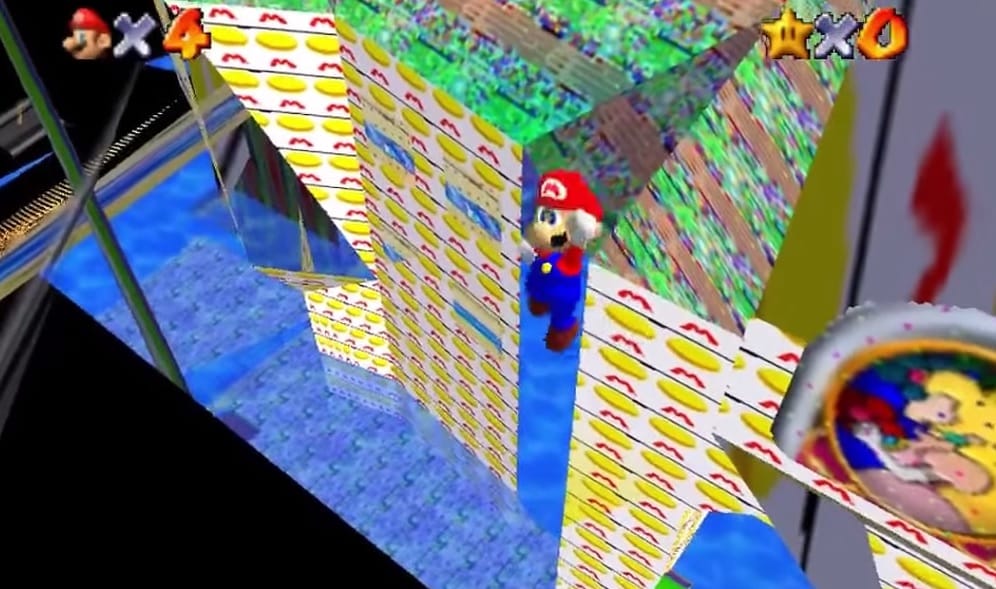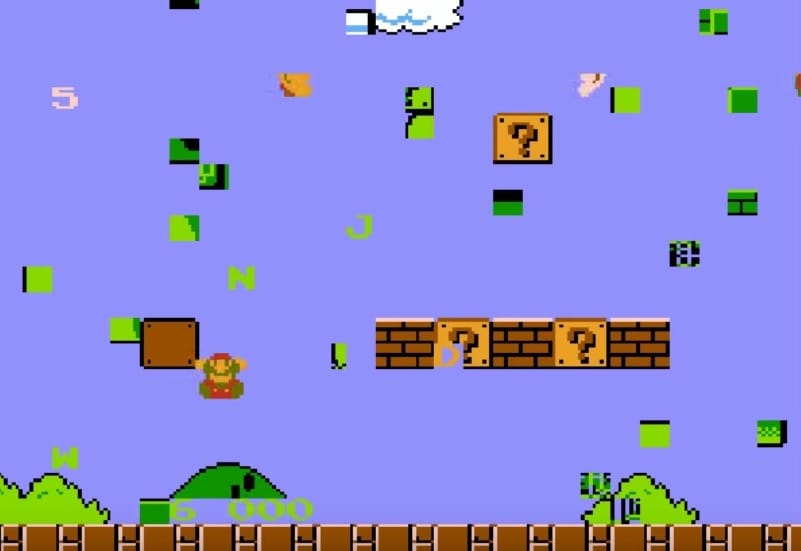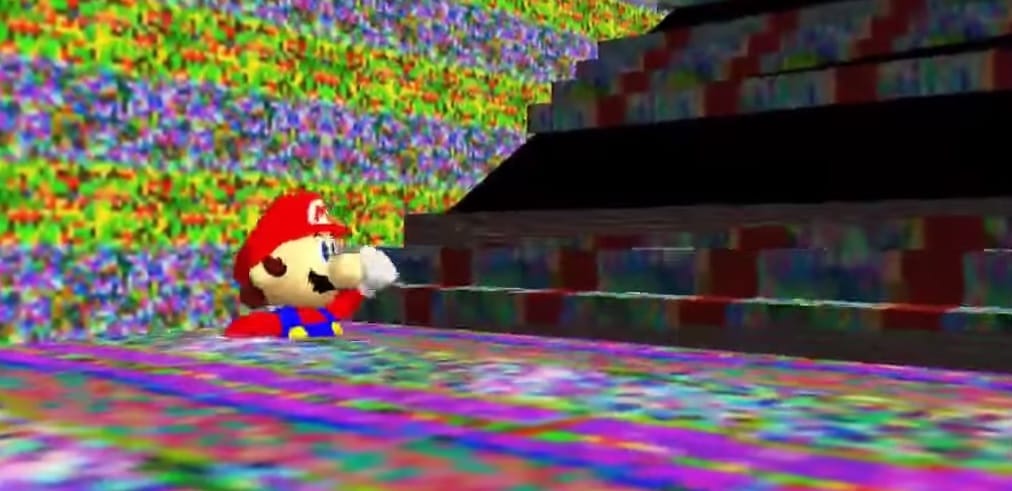The terrifying comedy of Mario glitches

This article is part of Mario Week, our seven day-long celebration of the 25th anniversary of Super Mario World and 30th anniversary of Super Mario Bros. To read more articles from Mario Week, go here.
///
Vinny boots up Mario 64 greeted by the familiar jocular “Hello!” from the disembodied Mario head at the game’s start. Except it’s not familiar. Mario’s head is squashed into a football shape, ears elongated so that he resembles Jar Jar Binks, and his black moustache acts as surrogate lips when he talks.
“I can’t make him look normal, guys,” Vinny says to his live audience after molding Mario’s face into an even uglier formation. “Something tells me it’s gonna get worse.” It always does.
Vinny founded the livestreaming group Vinesauce along with some like-minded streamers who all enjoy creating a distinctive and unusual brand of videogame comedy. Much of this comedy involves preparing software so that it becomes unstable and produces incongruous and vulgar scenarios. This could be downloading viruses onto Windows so that it becomes an unbearable cacophony of adverts and desktop helpers. Or modifying The Sims to remove all traces of Pleasantville and replacing them with homoerotic love stories of impossible pregnancy, endless violence, and blown-up babies. Sometimes an amateur videogame is played and its countless bugs and terrible writing is enough to get laughs—Mayro Kratt is a classic episode.

Each member of Vinesauce tends to have their own method of feeding this comedy. Vinny is most well-known for his corruption videos. The idea is to run videogames through a “corrupter” that deliberately messes with the code to produce unusual and unexpected results as they’re played. Vinny embraces the spontaneity of the corrupted software with his own improvised one-liners, often managing to be pithy and insightful with his choice of words in the face of such unmediated expression—what Vinny has deemed an “acid wonderland.” There’s something of an experimental jazz performance about the whole ordeal. The corrupted videogame is both saxophone and saxophonist, ripping apart the rigid structures of videogames with its chaotic tune, icons and rules lose their meaning to an unstoppable force of transgression. It’s usually the case that, eventually and unsurprisingly, the game crashes entirely—the ultimate deconstruction as the game manages to turn itself off.
The series that Vinny has subjected to this method of torture the most is Mario. Being parables of the 2D and 3D platformer, the idea of corrupting the Mario games may seem almost sacrilegious, as if attacking the foundation upon which many videogames have been built. But to watch Vinny’s livestreams, or one of his edited videos, is to see no such menace. It’s all playful curiosity broadcast only for entertainment’s sake. Why, then, has Vinny targeted the Mario games for his corruptions more than any other series? The answer lies somewhere within a long-standing personal fascination.
What are the Mario games to you? How has your relationship with them changed over time?
Mario games represent a lot of things to me. I grew up with them. They helped shape my reflexes and more importantly, my sense of wonder. I was always curious about the next enemy, the next power-up, the next level, the next world, the next game. It pushed me to get good at the game from a fairly early age.
I know Mario’s head was backwards
In many ways, Mario games ignited my love of videogames in a huge way. My older cousin bought an NES and Mario Bros. for me when I was three years old. I’ve never looked back since then. These days, I still enjoy playing Mario games. Mario 3 and Mario World are frequent replays for me. The newer games such as Mario 3D World and the Galaxy series have also captivated my interest. It’s great that Nintendo was able to keep the series fresh over the years, maintaining that anticipation for the next level that I had when I was a kid. Mario Maker looks to be a lot of fun and I can’t wait to return to the classic 2D styles with user-created levels, though I suspect some will induce intense frustration … something I don’t entirely dislike in a Mario game.
I’ve spent a lot of time glitching Mario games using a corrupter program. In some ways, this was an attempt to regain some of the wonder I felt when I first played the games. Corrupting the game can illicit all sorts of bizarre effects, such as new, mangled levels, bizarre power-up effects, broken physics, changed graphics, deformed enemies and more. Imagine going through level 1-1 in the classic Mario Bros., only to find a glitched King Koopa waiting for you near the flagpole. It’s insane, but it’s also a lot of fun.
In some ways, I’ve made sort of a career on corrupting videogames, but none are quite as fun to glitch as the classic Mario games. Maybe it’s the nostalgia I’ve retained from my childhood, or perhaps the games are especially prone to the strange effects of the corrupter. Whatever the case, my love of the Mario series has continued and grown in some ways, however unexpected they may be.

How did you first come across the idea of corrupting the Mario games? And could you explain how it is done?
I came across corruptions from a YouTube video about five years ago. I was surprised, confused, and highly amused all at once. I don’t remember much of the video, but I know Mario’s head was backwards and the levels looked like they were created by a chimpanzee on LSD headbanging on a keyboard. Around this time I had just started streaming, so I knew I wanted to try this out. I discovered the corruption program, something simply entitled “Corrupt.” After some trial and error I discovered how to use it and many thousands of corruptions later I still have no idea how it works.
OK, I know the basics. A corrupter alters the data in the game’s code to varying degrees. This means that a whole lot of random stuff can happen. Music can get pitched incorrectly, graphics can be distorted, and even the game physics can go awry. By changing the code in even subtle ways, unexpected insanity can happen. It’s possible to edit specific portions of a game’s code in order to effect only what you want to, but that requires patience and research.It’s more fun to corrupt live
Over the years people have taken to the task of creating different corruptors. A few notable examples are the Vinesauce ROM Corruptor (by Rikerz) and the Real Time Corruptor or RTC (by Ircluzar.) It seems my pointless and nonsensical corruption videos have actually inspired people to dedicate hours of time in creating better tools to screw up games even more. I currently use the RTC as it’s the easiest and most powerful Corrupter available. Instead of manually inputting numbers and experiencing a ton of downtime in between corruptions, the RTC can alter the game data live to whatever degree you wish. Essentially, breaking classic games is easier than ever at this point. Clearly the next step is physical cartridge corruptions, where you throw the game at the wall as hard as you can and try playing it after. Results may vary.
You’ve corrupted many different Mario games over the years. In your experience, are they all as entertaining to corrupt as one another?
The most entertaining corruptions for most people are the 3D games. Mario 64, Mario Kart 64, etc. That said, those are the most difficult to corrupt. Results come way easier with 2D games. Super Mario World, for example, can get really weird really fast. Music corruptions happen quickly, levels get rearranged, enemies can sometimes combine with other sprites and plenty more. With Mario 64, and other N64 games, the effects of the corruptions are somewhat limited.
When you’re corrupting games you’re usually doing so with a live audience. Do you think it’s a process that’s best watched live?
I stream my corruptions live because of the spontaneity of it all. Finding a good corruption is like diving to the bottom of a sewer and pulling up a gross, but shiny gold nugget. It’s more fun to corrupt live; there’s a greater sense of immediacy. A lot of the more complex corruptions are submitted to me by a great group of people in our community.
If I were to attempt N64 or PS1 corruptions live, there would be way more downtime than fun, so I stick to submissions for those systems and anything above. However, SNES, NES, and everything in between are usually a lot easier to get good results with. Any of my videos involved SNES or NES corruptions were likely found by myself while I was live. For my Metal Gear Solid corruptions, I spent a few hours offline finding interesting corruption combinations, saved them, then loaded them up live and experimented.
In what various ways does the audience participate in the show while you’re corrupting a game?
Aside from the audience submitting some corruptions, a lot of people draw art for us. There is a massive stockpile of corruption drawings on our art board. The audience makes the whole process so much more fun. With their art, I can see which moments they liked best and their interpretations of what the glitchy pixels look like to them. It’s like a Rorschach test on LSD!“Corruption Runs”
Another good thing about having a live audience is that sometimes they’ll notice things I don’t or give me an idea to pursue. This is for all of my streams, not just corruptions. I do enjoy the interaction, but it’s hard to keep up when there are a few thousand people chatting at the same time. Corruption streams tend to be really busy, but sometimes while I’m just playing through a game normally, I can interact a lot more with my audience. It’s a lot more fun that way.

Do you consider corrupting videogames to be transgressive?
Corruptions are so fascinating for people because they’re watching a game literally get ripped apart at the seams. I know they’ve inspired some people from our community to dig deeper into game code and understand how a lot of these games really work from a technical perspective. Other people were inspired to make better corruptors. Others have made fan games or romhacks incorporating the corruption aesthetic and/or their randomness and unpredictability.
With the advent of the Real Time Corruptor, I’ve discovered that is possible to play through games while they’re actively getting corrupted. Sometimes they freeze up or it becomes impossible to progress, but it’s totally possible to play the games you’ve played a hundred times in a new way. Granted, this new way may involve completely broken physics and graphics that defy any real interpretation, but it can be a lot of fun to experience your favorite games in new and bizarre ways. “Corruption Runs” as I call them aren’t quite an exact science, but I’m working on the rules slowly but surely. Maybe one year we’ll see them at a Games Done Quick!
///
This article is part of Mario Week, our seven day-long celebration of the 25th anniversary of Super Mario World and 30th anniversary of Super Mario Bros. To read more articles from Mario Week, go here.



